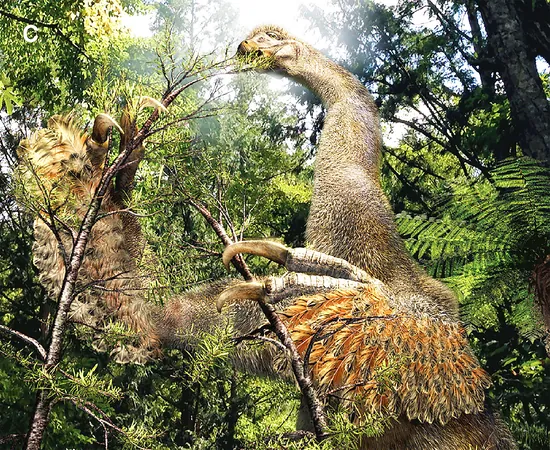
Scientists Unearth Bizarre Two-Clawed Dinosaur: Meet Duonychus tsogtbaatari!
2025-04-03
Author: Sophie
In an astonishing paleontological breakthrough, researchers have revealed the unexpected existence of a dinosaur with just two massive claws, dubbed Duonychus tsogtbaatari. This newly identified species, discovered in the depths of Mongolia’s Gobi Desert, is sparking curiosity and excitement among scientists and dinosaur enthusiasts alike.
A Claw-some Discovery!
Paleontologists from the University of Calgary and Mongolia's Institute of Paleontology stumbled upon well-preserved fossils that included an iconic keratin claw sheath—similar to human fingernails—suggesting these formidable appendages once reached nearly a foot (30 cm) in length. "This is the largest claw preserved with a keratin sheath that we’ve found in a dinosaur," remarked Darla Zelenitsky, a key researcher in the study.
The Evolutionary Puzzle of Duonychus
Duonychus tsogtbaatari is classified as a therizinosaur, a cousin of the infamous Tyrannosaurus rex. However, it diverges dramatically from its carnivorous relatives. Unlike most theropods, which hunt for food, therizinosaurs have evolved into herbivorous or omnivorous creatures. With adaptations such as a small head, beak-like mouth, and peculiar leaf-shaped teeth, Duonychus was built for munching on vegetation.
Using its gigantic claws, which could also preface a giraffe's reach when stretched upwards, this dinosaur presumably navigated tree branches and grasped foliage, demonstrating an entirely unique feeding strategy.
The Fascinating Features of a Prehistoric Oddball
Duonychus stood approximately 10 feet (3 meters) high and weighed around 573 pounds (260 kilograms). With notably only two robust fingers on each arm, scientists likened its claws to oversized barbecue tongs. "These claws could have served multiple purposes, from foraging to potential defense mechanisms," stated Zelenitsky.
It's fascinating to consider that while Duonychus was not a predator, its claws were sharp enough to deter threats—far from the steak knife-like claws of its carnivorous relatives, these were designed for survival in a very different way.
Claws and Feathers: A Prehistoric Paradox
Interestingly, the therizinosaur lineage is closely linked to modern birds and other feathered dinosaurs. Fossil evidence suggests Duonychus was likely adorned with feathers, which adds a unique twist to its already peculiar appearance. This newfound evidence enhances our understanding of how these dinosaurs might have lived and interacted with their environment.
Unique in the Dinosaur Kingdom
Fossils of Duonychus not only included its notable claws but also parts of its spine, tail, and legs, offering paleontologists a more comprehensive picture of this extraordinary dinosaur. This discovery challenges previous assumptions about dinosaur anatomy and evolutionary adaptation and signifies how much more there is to learn about these ancient creatures.
The implications of this find are profound, encouraging a reevaluation of our understanding of dinosaur diversity and evolution. "We could have never believed in this strange creature if we hadn't found its fossils," expressed paleontology expert Steve Brusatte.
This landmark discovery promises to reshape our comprehension of dinosaur life, revealing that ancient ecosystems were filled with creatures far stranger than we can imagine. With ongoing studies, there is no telling what more insights we might uncover about the fascinating world of dinosaurs!









 Brasil (PT)
Brasil (PT)
 Canada (EN)
Canada (EN)
 Chile (ES)
Chile (ES)
 Česko (CS)
Česko (CS)
 대한민국 (KO)
대한민국 (KO)
 España (ES)
España (ES)
 France (FR)
France (FR)
 Hong Kong (EN)
Hong Kong (EN)
 Italia (IT)
Italia (IT)
 日本 (JA)
日本 (JA)
 Magyarország (HU)
Magyarország (HU)
 Norge (NO)
Norge (NO)
 Polska (PL)
Polska (PL)
 Schweiz (DE)
Schweiz (DE)
 Singapore (EN)
Singapore (EN)
 Sverige (SV)
Sverige (SV)
 Suomi (FI)
Suomi (FI)
 Türkiye (TR)
Türkiye (TR)
 الإمارات العربية المتحدة (AR)
الإمارات العربية المتحدة (AR)